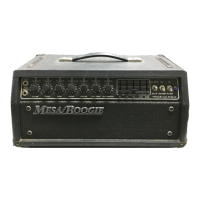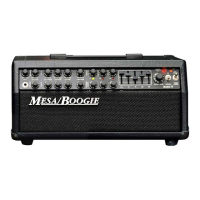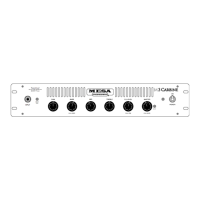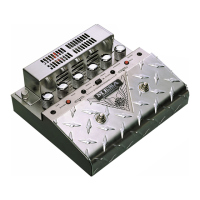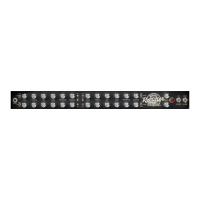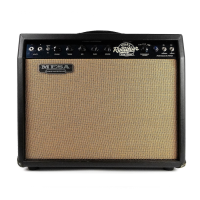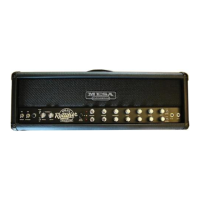- 2 -
With only a little Practice you should be able to work these controls to provide just the right rhythm tone
and just the right lead tone with the loudness of both independently adjustable by the Master controls. So
hit the Standby and go ahead and try it!
The Slave Level control and Slave Output jack located on the rear panel of the amplifier give you a direct
output feed which faithfully captures the entire sound of the amp and preamp and can be regulated to
properly match anything from a mixing board to a power amp to another Boogie for a linked up
arrangement. Although a few mixing boards (mainly Yamaha) won't properly accept the Slave Output
signal and cause distortion, an absolutely noise free recording can be made with most other mixers. Set
the amp normally. Start with the Slave knob off. While playing, turn it up to provide sufficient signal for
your power amp or Line In on your mixer. Higher Slave settings and lower Master settings will result in
lower overall noise. Always run the Boogie with a speaker or load resistor (8 to 20 ohms, 50 watts) if you
are using the Slave Out. A Pre Amp Out-Pwr Amp In jack is located on the bottom of the chassis and
provides access to the junction of the preamp and the output power amp. With it, another Boogie can be
linked up (Slave Out of the first amp to Pwr Amp In of the second), or it can allow you to use the Boogie
as a preamp only.
For weaker incoming signals, the Effects Return can be used as an input and then the Graphic
would be functional. For Effects Loop use the jacks Mounted on the back panel. The Effects Return Jack
will interrupt the signal flow while the Effects Send can be used as an output without affecting signal flow.
If your Boogie should ever lose power or die out, always first run a cable between the two Effects Jacks
before proceeding to test tubes, etc., as such a problem could likely be caused by faulty switch contacts
in the Effects Return Jack.
Also on the back panel are the Reverb (optional) and Presence controls. The Presence control used from
0 to 3 will cut highs resulting in a smooth, mellow tone at a lower overall volume. Used from 4 to 10 it will
boost both volume and highs. Three speaker jacks are provided: one 8-ohm and two 4-ohm. With 60
watts models, plug the single 8-ohm speaker into the 8 ohm jack for the most power and clarity. If two 8-
ohm speakers are used, plug each one into a 4-ohm jack for proper balance. But you may also try other
combinations if you want one speaker slightly louder or happen to prefer the tone caused by a slight
mismatch; it will do no harm to the amplifier. With 100/60 watt models we recommend that when you run a
single 8-ohm speaker you use the 60 watt position and plug into a 4-ohm jack. This will give the strongest
possible output without damaging the speaker. You may get more clean power by switching to 100 watts,
and still more by also plugging into the 8 ohm jack but remember to avoid lead tone distortion as it
increases power dramatically (though not so much the apparent loudness) and may cause speaker
damage. With two 8-ohm speakers, one in each 4-ohm jack, the 100 RMS can be safely used. A cabinet
with four 8-ohm speakers can be wired in series-parallel to give a total load of 8-ohms, or a 16-ohm
Marshall box may be wired in parallel to obtain 4 ohms. Use a speaker jack for headphones. Again, no
harm can be done to the amplifier by mismatched speaker loads and we encourage you to experiment, if
you want, with various combinations.
Also located beneath the chassis is a stereo socket for the optional Dual Footswitch. This will be wired to
activate, when applicable, the Graphic EQ and Reverb. When an amplifier is built with only Reverb or
Graphic, a mono ¼” guitar jack is mounted for use with our Single Footswitch and Cable Set. If your
amplifier is equipped with a cooling fan and you wish to turn it off for quiet studio playing, then unplug the
fan power cord where it plugs into the chassis on the extreme left end. Most of all, this amp was made for
your enjoyment -- so go for it!!

